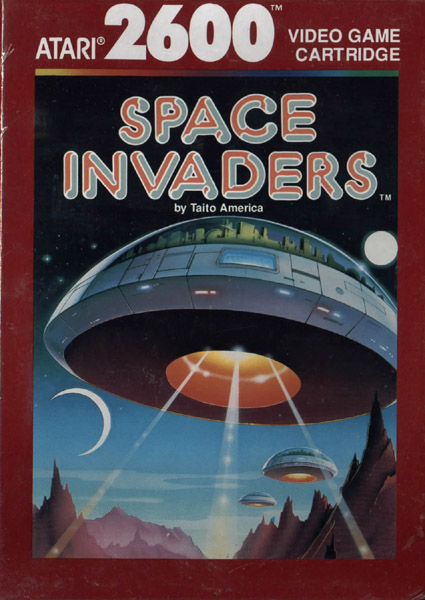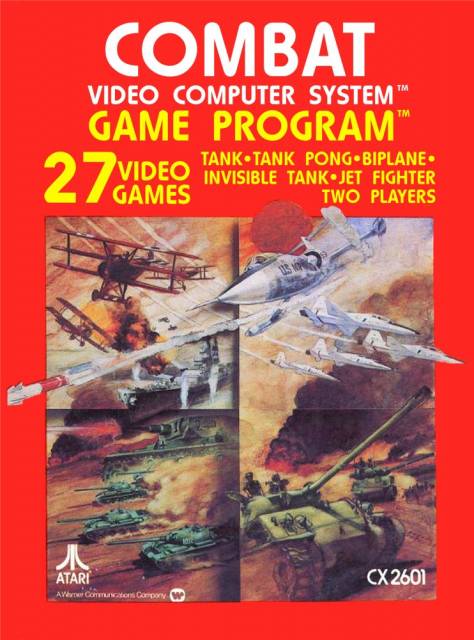Overview
 Classic Arcade games such as Space Invaders were remade for the 2600
Classic Arcade games such as Space Invaders were remade for the 2600The Atari Video Computer System (VCS, renamed 2600 in 1982) is a cartridge-based game console, released in 1977. Atari's prior success with Pong, both in arcades and in the home, lead to the development of the VCS. It was largely successful due home versions of arcade games such as Asteroids, Space Invaders, and Centipede as well as first- and third-party games developed specifically for the console, such as Pitfall and Adventure. The Atari 2600 made the home video game market mainstream, selling 30 million units worldwide before being discontinued in January 1, 1992.
Hardware
The VCS is a second generation 8-bit game console. Video and sound output are handled through an RF modulator; the TV-Game switch. At least 6 different VCS/ Atari 2600 consoles were released, with different aesthetics and placement of the various switches.
Video is handled by the 1.19MHz 6607 CPU, with 128 bytes of RAM (thought cartridges could supplement this with 128-256 bytes). The NTSC and PAL versions have somewhat different specifications due to varying video standards - with the NTSC version supporting 128 colors, while the PAL version supports 108.
Input is handled through the included single button joystick, or two for multi-player games, and a few games which use them in tandem. Additionally, Atari offered several other input devices. Paddle controllers, consisting of an analogue wheel and a side-mounted button were appropriate for games requiring precise motion on one axis, such as Kaboom! and Breakout. Keypad controllers feature 12 buttons, and can slide-lock into one another. Overlays exist for a few titles (most notably, Star Raiders) which sit atop the keypad controllers. Other, game specific controllers were also offered, such as the driving controller; a paddle variant with 360 degree motion, and a light gun. Third-party hardware manufacturers also offered several controllers.
Hardware Design
During the initial development of the system concerns regarding the system's cost to manufacture and at retail would lead to a remarkable hardware design. This is turn influenced how software would be written for the system. Despite the system using a version of the popular 6502 processor (which drove many computers and consoles at the time) the processor interfaced with with display in a unique and distinct manner through the use of the Television Interface Adapter (TIA). The consequence of this design choice forced programmers for the 2600 to ensure that each individual line of each frame of the television picture was ready as the electron gun starts to light it up as it travels down the screen.
Launch titles
United States
The Atari 2600 launched along with the following 9 games in October 1977:
 Combat
CombatVideo Game Market Crash of 1983
In 1983, the video game market was going into a decline. Atari was getting hit the hardest by this crash- after all, this nightmare was caused partially by Atari itself. The main problem with the 2600 at this time was that its game lineup became overcrowded with bad games. This was mostly because Atari had placed no limitations on who could develop games and how many games could be put out in years or even financial quarters, which is now a mainstay in the video game business first implemented by companies like SEGA and Nintendo. This was around the time that Activision broke off from Atari for more developmental freedom, becoming the first third-party publisher. During 1983, the market was saturated with hundreds of games, with most of them being of poor quality. Since anyone could make games for the Atari 2600, there were all kinds of companies making games who had no place doing so: i.e. cereal and dog food companies, which people would buy and get a refund for later or just ignore. With limited shelf space, retail outlets would eventually stop ordering new software while underselling older products just to make some shelf space. Games were heading into bargain bins, and the games market was going with them.
 E.T for the Atari 2600 was a massive financial failure
E.T for the Atari 2600 was a massive financial failureTwo games are often the scapegoats of The Great Games Crash of 1983: the Atari 2600 version of Pac-Man and E.T.. Atari decided to get the exclusive rights to port Pac-Man (the most popular arcade game during the time) to the Atari 2600. This idea looked excellent on paper, but in practice was a dismal failure. The final release of Pac-Man for the Atari 2600 VCS barely resembled what the arcade version was. It was ugly, barely played, and had a sound that would likely haunt your mind to this day if you'd hear it. This version was actually a prototype-a proof of concept with no polish and little developmental time, yet was released anyways. In a rash assumption, Atari printed up more copies than there were Ataris owned, assuming the game would sell systems. The result could not have been more disastrous. Very few copies were sold and Atari was stuck in an awkward financial situation. E.T. was its own disaster. The same sort of hubris occurred and Atari, so sure of itself, pressed too many copies once more. However, the game was of such poor quality that many sold copies of E.T. were returned and refunded. This was such a disaster that it was more cost effective for Atari to simply bury all the copies in a landfill in New Mexico (this was once thought to be only a rumor, but has proven to be true). Atari never truly recovered from this shock.
Log in to comment